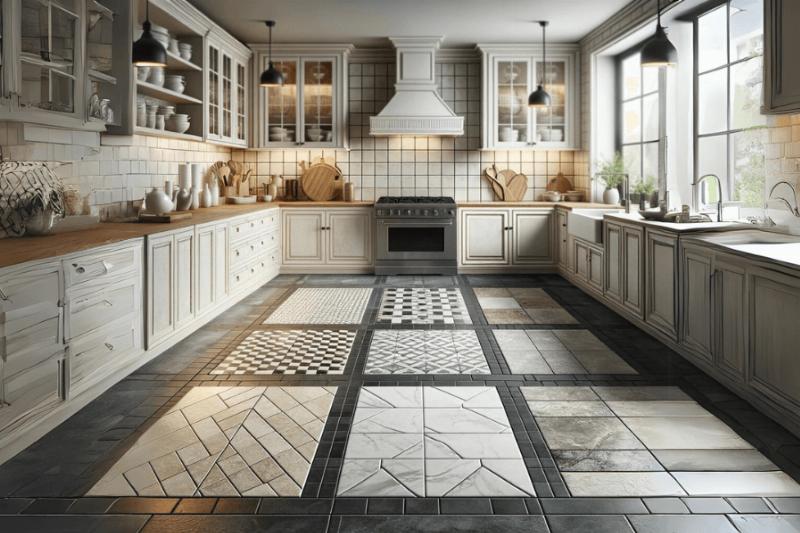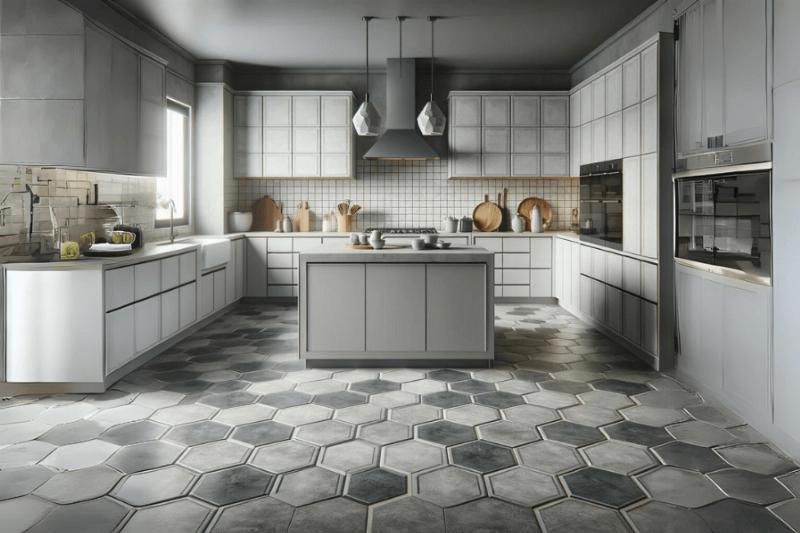The Better Business Bureau (BBB) states that, on average, a single-story home in the United States features a kitchen of approximately 161 square feet. Whether your kitchen is small or large, the flooring you choose plays an important role.
Kitchens endure a lot, particularly in households with pets or children. There, it serves as the most frequented and accident-prone area, especially if it is not well-designed. Selecting the right flooring is essential to maintaining a safe and functional kitchen space. However, the challenge lies in finding kitchen floor tiles that are both functional and visually appealing. It’s crucial to opt for flooring types that can withstand dropped objects and accidental spills.
Today, we’ll explore the 10 best kitchen tile ideas to help you find the ideal balance between functionality and style.
Understanding Kitchen Floor Requirements
When selecting the best tile for kitchen floors, it’s essential to understand the unique challenges and key considerations that come with this area of the home.
Unique Challenges for Kitchen Floors
The kitchen is not just another room; it’s a dynamic space that requires flooring that can withstand a variety of challenges. A few are given below:
1. High Foot Traffic
Kitchens are often the heart of the home, frequented by family members and guests. This constant use can quickly wear down flooring that isn’t built to endure heavy foot traffic.
2. Spills and Stains
Kitchen flooring is vulnerable to spills of everything from water and oils to wine and acidic materials. The perfect kitchen floor should be stain- and spill-resistant as well as easy to maintain.
3. Humidity and Temperature Changes
Kitchens experience fluctuating humidity and temperature levels due to cooking, boiling, and other activities. Flooring materials need to be able to withstand these changes without warping, cracking, or becoming damaged over time.
Key Considerations for Selecting Tiles
When you are selecting tiles for the kitchen floor, there are a few factors to consider.
1. Durability
The durability of kitchen flooring is paramount. The material should be tough enough to resist chipping, cracking, and other forms of wear and tear. The longevity of the flooring is a crucial factor, as replacing kitchen floors can be expensive and disruptive.
2. Slip Resistance
Safety in the kitchen is crucial, given the likelihood of spills. Tiles with a higher slip resistance are preferred to minimize the risk of accidents. Some tiles come with a textured surface or anti-slip properties, making them safer underfoot, especially when wet.
3. Ease of Cleaning
Hygiene and ease of maintenance are vital in a kitchen. Tiles that are easy to clean and maintain make it simpler to keep the kitchen hygienic. Non-porous materials are generally easier to clean as they don’t absorb spills, which can lead to staining and bacterial growth.
4. Aesthetic Appeal
While functionality is vital, the aesthetic appeal of the tiles must be noticed. The kitchen floor contributes significantly to the overall look and feel of the space. Tiles come in a wide range of colors, patterns, and textures. So, you have got numerous design possibilities to complement any kitchen style, from modern to traditional.
Types of Tiles Suitable for Kitchen Floors

Choosing tiles for your kitchen floor is like picking the right ingredients for a recipe. Here is a look at different types of tiles that are suitable for your kitchen floor.
1. Porcelain Floor Tiles
Porcelain floor tiles are made by mixing sand with clay mixture. Then, the tiles undergo a process of heat and pressure, resulting in a tile that surpasses regular ceramic tile in hardness, density, and porosity.
Porcelain floor tiles are ideal for high-traffic areas, kitchens, and bathrooms. It boasts durability that extends to outdoor use in any climate. There are two variations of porcelain tiles: glazed and unglazed. Glazed porcelain features a glass-like coating applied during firing, which results in a coloured surface. On the other hand, unglazed porcelain has color in the clay mixture, which ensures that the color and pattern permeate the entire tile.
Pros
- Highly durable and suitable for high-traffic areas like modern kitchens
- Dense and water-resistant, facilitating easy cleaning
- Versatile, capable of replicating the appearance of materials like wood and stone
- More budget-friendly compared to natural stone
Cons
- Chipping over time may expose the white interior.
- Installation can be challenging because of specialized tools and expertise.
2. Ceramic Floor Tiles
Regular ceramic floor tile is sometimes known as “non-porcelain. “However, it differs from porcelain since it is made of clay. It is softer than porcelain and undergoes glazing to create a durable surface available in various colors.
While its softer nature makes it easier to cut and install, it is more porous than porcelain. However, the applied glazing renders it resistant to kitchen spills and splashes.
Pros
- Cost-effective and budget-friendly
- Low maintenance with resistance to stains and moisture
- Versatile design options offer colorful, patterned, matte, subtle, or glossy finishes.
- There is no need for sealing, and it is easier to clean compared to natural stone tiles.
Cons
- Higher porosity compared to porcelain. It makes them more prone to staining over time.
- Potential for mold growth beneath tiles
- Lesser durability than porcelain and natural stone
- Risk of exposing the interior if the top surface becomes chipped.
3. Stone Floor Tiles
Stone floor tiles made of natural materials such as slate, granite, limestone, travertine, and marble are gorgeous. However, most stone tiles are porous and require regular refinishing with a quality stone sealer every two to three years.
These tiles can be either polished or honed. Polished surfaces, while visually stunning, can be slippery when wet. On the other hand, honed stone tiles provide more traction but have a less vibrant appearance.
Stone, known for its beauty and durability, requires sealing and is typically the most expensive option. Large format styles are popular, minimizing grout lines to create a more spacious feel in smaller kitchens.
Pros
- Durable and visually stunning, each slab has a unique appearance.
- There is a wide range of natural stone varieties, from neutral to dark tones, for complementing color palettes.
Cons
- They are generally more expensive than other tile options, affecting the entire budget.
- Due to various degrees of porosity, stone tiles require more intense care, including regular sealant applications.
What Are the Latest Trends in Kitchen Floor Tiles?

In today’s modern kitchen design, the flooring landscape is witnessing dynamic trends. The current trends in kitchen flooring materials are gravitating towards light-coloured tones and natural materials. This aesthetic choice not only enhances the visual appeal but also extensively integrates with other elements within the kitchen space.
Homeowners are increasingly opting for large tile sizes, a trend driven by the desire to minimize the number of grout joints. It will create a cleaner and more expansive look.
To achieve a wood flooring texture, experts recommend exploring vinyl kitchen flooring ideas, particularly luxury ceramic tiles. These options can be customized to replicate the natural appearance of wood or stone, plus you will get the practical advantages of easy maintenance and water resistance.
In terms of design innovation, diamond shapes, hexagons, and chevrons are changing the conventional norms of kitchen floor tiles. Many homeowners are opting for unconventional layouts, such as laying oblong tiles in a herringbone pattern, as well as integrating terrazzo for a touch of modern sophistication. These trends reflect a shift towards creative and personalized approaches to kitchen flooring.
What to Look for in Kitchen Floor Tiles That Resist Dirt?
For those seeking kitchen floor tiles that don’t readily reveal dirt, experts suggest avoiding highly light colors. Matte finishes are recommended over glossy tiles, as they tend to hide dirt better and reduce the risk of slipping.
If you’re an avid cook or have kids in the house, go for easy-to-clean tiles. Porcelain tiles are one of your reliable options.
| Aspect | Details about Porcelain Tiles |
| Porosity | Non-porous |
| Stain Resistance | High (Stain-proof) |
| Ideal Usage | High-traffic areas like kitchens |
| Maintenance | Easy |
| Safety and Cleanliness | Enhanced: provides a clean and safe environment |
Transform Your Kitchen with New Kitchen Floor Tiles
Transforming your kitchen with new floor tiles is an exciting way to refresh your kitchen. Smart Remodeling LLC, nestled in Houston, Texas, offers a vast array of lifestyle displays and product samples that can inspire your kitchen’s transformation. With an expansive selection from top brands, you’re sure to find the perfect tile design that reflects your style and fits your budget.
With Smart Remodeling LLC, you’re not just choosing new tiles; you’re ensuring a positive renovation experience that is promised to be enjoyable and low-stress. They take pride in fulfilling your vision while keeping true to their 5-year guarantee.
Final Verdict
Choosing tiles for kitchen flooring is a wise selection because of their longevity, resistance to prolonged moisture exposure, and ability to act as a neutral canvas for vivid designs. When choosing among options like natural stone, ceramic, and porcelain tiles, each variety boasts unique characteristics catering to different preferences.
Porcelain tiles, in particular, are a popular choice for many as they offer durability and easy cleaning. As with any decision regarding kitchen finishing, the optimal flooring type depends on your specific maintenance requirements and the aesthetic you wish to achieve in your kitchen space.







